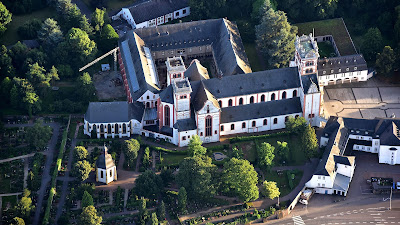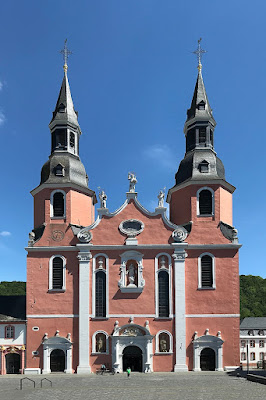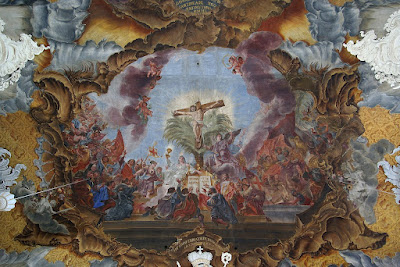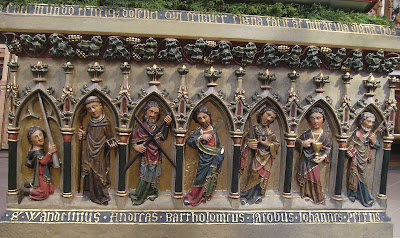Basilicas in Germany—Rhineland-Palatinate and Saarland
Basilica of St. Matthias, Trier, Rhineland-Palatinate
Declared a minor basilica by Pope Benedict XV in 1920.
The basilica is the abbey church for a Benedictine monastery established in the 10th Century. It also contains the tomb of St. Matthias the Apostle. The Romanesque church was consecrated in 1148. The monastery was closed between 1802 and 1922.
All pictures are from Wikipedia.
Imperial Cathedral Basilica of Sts. Peter and Paul, Worms, Rhineland-Palatinate
Declared a minor basilica by Pope Pius XI in 1923.
The church was once the cathedral for the former Diocese of Worms. A church has been on this site since the 7th Century. A larger cathedral was built in the 11th Century—apparently poorly as it was soon torn down. The current Gothic church was mostly completed by 1181 although additions were later made. The Diet of Worms was held here in 1521 at which time the Holy Roman Emperor, Charles V, summoned Martin Luther to renounce his views. Luther refused and was condemned as a heretic. This area nevertheless became heavily Protestant and in the 1630s, occupying Swedish troops used the church for Protestant services. The church later became Catholic again and renovations were made in the 1690s. The French Revolution, which had spread to this area, once again impacted the church. It fell into disrepair until 1886 when it was renovated.
All pictures are from Wikipedia.
Cathedral Basilica of Our Lady of the Assumption and St. Stephen, Speyer, Rhineland-Palatinate
Declared a minor basilica by Pope Pius XI in 1925.
This is the Cathedral for the Diocese of Speyer and is one of three Romanesque Imperial cathedrals in Germany. It is the largest Romanesque church in the world. The church was initially completed in 1061 and enlarged by 1106. The building burned completely in 1450 was rebuilt and burned again in 1689. The church was once again rebuilt in the 1700s but was profaned by French Revolutionary troops and later by Napoleon’s army. The church was restored between 1818 and 1822 and has been renovated since then. At least three Holy Roman emperors are buried in the basilica.
All pictures are from Wikipedia.
Basilica of the Assumption of Our Lady at the Lake, Maria Laach, Rhineland-Palatinate
Declared a minor basilica by Pope Pius XI in 1926.
A Benedictine monastery was established in 1093 on the banks of Lake Laach. The Romanesque abbey church dates to the 12th Century. The monastery was closed by the government in 1802, but was reopened by the Jesuits in 1863. The Benedictines returned in 1892.
All pictures are from Wikipedia.
Basilica of Our Lady of the Assumption, Streithausen-Marienstatt, Rhineland-Palatinate
Declared a minor basilica by Pope Pius XI in 1927.
The church is the abbey church for a Cistercian monastery. It was initially established in 1134 and moved to this location in 1222. The Gothic church dates to 1227. The abbey closed in 1803 but the church remained open for the local people. The monastery reopened in 1888. Today the monastery has a library, a brewery and restaurant, a book and art store, a guest house, and a secondary school.
All pictures are from Wikipedia.
Basilica of St. Martin, Bingen am Rhein, Rhineland-Palatinate
Declared a minor basilica by Pope Pius XI in 1930.
A church may have existed here as early as the 5th Century and a monastery was established at least as early as the early 11th Century. What is known is that the monastery’s Romanesque church (and much of the town) burned down in 1403. The current Gothic church opened in 1416. The monastery buildings were torn down in 1819 and the church was renovated. Damage during the Second World War resulted in another renovation ending in 1958.
The first picture is from Flickr and the others are from Wikipedia.
Basilica of the Transfiguration of Our Lord, Prum, Rhineland-Palatinate
Declared a minor basilica by Pope Pius XII in 1950.
A Benedictine monastery was built here in 721. The current red sandstone abbey church was built between 1721 and 1730. The abbey closed in 1802. The city of Prum and the church were badly damaged by American bombs during the Second World War. Restoration of the Gothic church was completed in 1950 and additional restoration started in the late 1990s and continues. A relic of Christ’s sandals was given to the church by Pepin III, King of the Franks.
All pictures are from Wikipedia.
Basilica of Our Lady of the Assumption, Trier, Rhineland-Palatinate
Declared a minor basilica by Pope Pius XII in 1951.
The basilica is adjacent to the Trier Cathedral and is thought to be one of the two oldest Gothic churches in Germany. The church was built in a largely circular design between 1230 and 1260 and it replaced a 4th Century church. A Madonna and Child statue dates to the 14th Century. The church survived the French Revolution and Napoleon, but was heavily damaged during the Second World War. It was restored between 1946 and 1951.
The first picture is from Flickr and the others are from Wikipedia.
Basilica of St. Paulinus, Trier, Rhineland-Palatinate
Declared a minor basilica by Pope Pius XII in 1958.
The church is built on the site of a Roman cemetery. According to legend, those buried here were members of the Theban Legion, a Roman legion executed because they had converted to Christianity. A church was built here in the 4th Century and named after a 4th Century bishop of Trier. This ancient church was replaced by a Romanesque church in the 12th Century. This church was destroyed by the French in 1674 and replaced by the current Baroque church in the early 18th Century. Much of the interior work is attributed to Balthasar Neumann. The church survived French revolutionary occupation and Napoleon was said to have been impressed by the church’s beauty. Portions of the pipe organ date to the mid-1700s.
All pictures are from Wikipedia.
Basilica of St. Wendelin, Sankt Wendel, Saarland
Declared a minor basilica by Pope John Paul XXIII in 1960.
The Gothic church was built in the 14th and 15th Centuries to replace an earlier (9th or 10th Century) church. Both churches were dedicated to St. Wendelin, a 7th Century saint.
All pictures from from Wikipedia.
Basilica of St. John the Baptist, Saarbrucken, Saarland
Declared a minor basilica by Pope Paul VI in 1975.
A church has been on this site since the 7th Century. The current Baroque church was built in the mid-1700s. The pulpit dates to 1764 and the rococo confessionals to 1789.
All pictures are from Wikipedia.
Basilica of St. Castor, Koblenz, Rhineland-Palatinate
Declared a minor basilica by Pope John Paul II in 1991.
A Roman fort was established on this site during the reign of the Emperor Augustus. A Roman temple was later built here and the first St. Castor Church was built in the 9th Century. The current Romanesque church dates to the 12th Century, although work continued for many centuries thereafter. A monastery was built here as well, but it closed during the French Revolution. The church was heavily damaged during the Second World War but has been restored.
All pictures are from Wikipedia.
Basilica of St. Severus, Boppard, Rhineland-Palatinate
Declared a minor basilica by Pope Francis in 2014.
A church was built on this site in the 6th Century on the remains of a Roman bath. This church burned in the 10th Century and was replaced by the current Rhenish Traditional church in 1236. The church has a crucifix above the main altar which dates to 1230, a Madonna dating to 1260, pews dating to 1692, liturgical vessels dating to the 14th and 15th Centuries, and bells dating to the 13th Century.
All pictures are from Wikipedia.































































